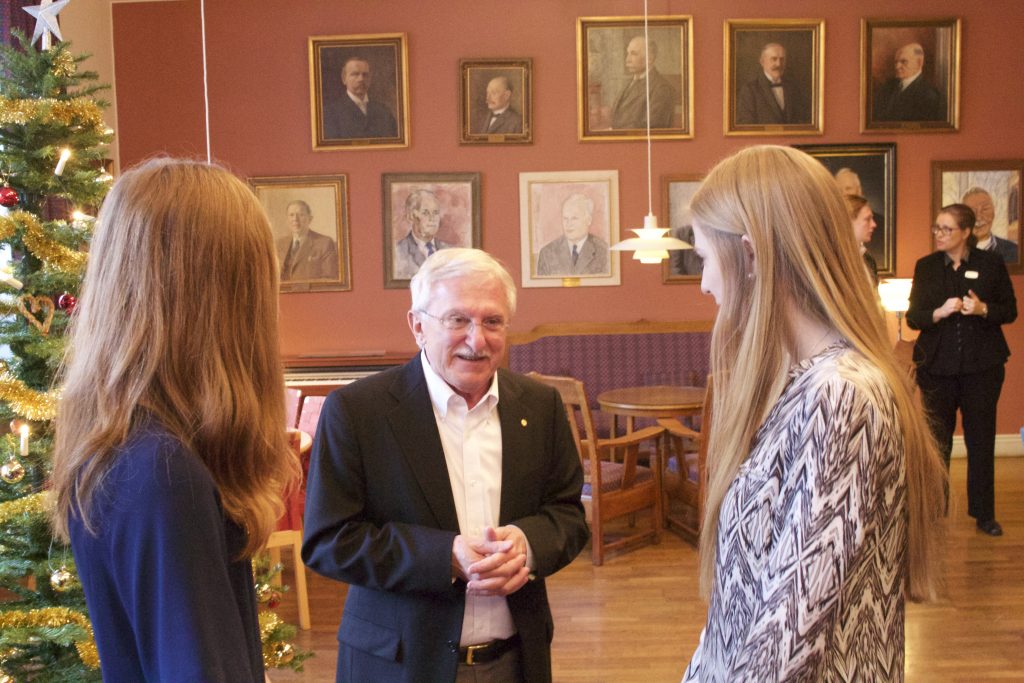
On Wednesday the 9th of December, Professor Modrich and Professor Sancar, two of the three Chemistry Nobel prize winners, visited Kungsholmen. Greeted with lussebullar and elevvärdar, they gave us a lecture on their discoveries. While the science may have been beyond us in some cases, everybody got an idea of the overwhelming importance of their discoveries. Not only does base excision repair, for instance, help us understand cancer more fully, it also may be the key to understanding human ageing. These two scientists graciously granted KZINE a private interview and shared their tips on how one maximizes the chance of receiving a Nobel prize.
In the pause between the lectures and the question session, we hurry downstairs to the conference room below the auditorium. There we are allowed a couple of minutes interview with both of the laureates, Professor Modrich and Professor Sancar. We start off by asking what the laureates were most excited about. In his soft Texan accent Professor Modrich shares the details of the fully packed Nobel week; they even have a minute schedule printed of all the different activities. He proudly shows us his little booklet, which is small enough to be tucked away inside a suit pocket and is printed in golden letters on thick paper. It turns out that even Nobel laureates get nervous – Professor Sancar explains that it is not until now, when his big presentations are over, that he can wholeheartedly look forward to all the events. A smile comes across his face and he tells us with great excitement that to the grand feast he will bring his 22-year old goddaughter, who studies Women’s Studies at university. However, it is still a mystery who his table partner will be at the actual Nobel dinner. Neither him nor Professor Modrich knew that they would eventually end up next to Princess Madeleine and Princess Christina, the king’s sister.
While the reason for the actual festivities is a major contribution to any of the five fields of research, Professor Modrich is the first to explain the different types of contributions that could possibly earn somebody a Nobel prize, and the reason he has received one. The first type is in a mature field, where most research will most likely be a moderate contribution, but where there may still be fundamental questions to be answered. This is the type of research Professor Modrich undertook. His discovery is notable as it neatly filled a gaping hole in the fundamentals of biochemistry. This opens the door to a much deeper understanding of the field and solves many previously unanswerable questions (such as understanding human ageing as previously mentioned). The second type of contribution is the less understood fields, which might be more risky, but where any correct answers constitute a major role in shaping the future of the field. During this part of the conversation Professor Modrich is offered fika and whispers to us that he has already started the day with a massive breakfast. However, he politely goes off to have a lussebulle anyway, which leaves us to infer that the best shot for getting a Nobel prize would probably be in one of these “less known” fields of discovery. Or this would at least put you on the possible fast track to a prize, if there is such a thing.

However, Professor Sancar would add to Professor Modrich’s explanation. Persistence is another key to optimizing your chances for a Nobel prize, according to him. He also describes that a lack of ideas is rarely the limiting factor, but rather technology. This is the reason his research took 20 years to complete, as technology was lacking or absent. Therefore, his best advice is to stubbornly keep at it, a testimony to his 20 years of hard work, and then, ”when technology comes around you’re ready”. Professor Modrich complements this by stating that naturally you have to love what you do, otherwise you will not have the patience or interest to see things through until the end. The reason for Professor Modrich’s perseverance, is that he loses interest in a problem as soon as he finds the answer. It is the process of getting there that brings him joy. DNA, with its previously missing knowledge, was the perfect problem to tackle therefore. Don’t all of us wish that we loved writing research papers more than completing them?
While these pieces of advice may not be news, it is heartening to hear them from the mouth of a Nobel laureate. If we use the analogy of the hare and the tortoise, as Professor Sancar did during his presentation, the path towards a Nobel prize is clearly a marathon, not a sprint. However, finding a new route may be key to winning the race. Or maybe the discovery of some running shoes that are better for running? Perhaps assiduous training and trying to enjoy the ride is what pays off in the end? Luckily the analogy ends here, before it gets too confusing, or before the enzyme photolyase (discovered by Professor Sancar) becomes a factor affecting the race. While it was Professor Modrich and Professor Sancar who received the prize this year, who knows who will in 30 years. Subtly implying: it might be you!

